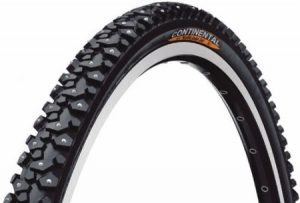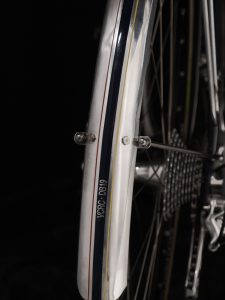When pairing proper clothing with a bike fitted with mudguards or fenders, there are few weather conditions that can make a ride unpleasant. Their protection keeps water from soaking the chamois, and they prevent road grit from turning Lycra into sandpaper. Gone is the spray off of the front wheel that drenches feet along the freezing plume of water off of the back wheel. And on a club ride, everybody is more comfortable without a constant wheel-spray showering their face.
While riding in the rain, the majority of the water comes off of the wheels. And once that spray is eliminated, a cyclist with a good rain jacket can stay quite dry for the duration of any ride. My father, Mike Barry, carries a proper cape on his small rear carrier for commuting, when rain is in the forecast. Rain jackets are more aerodynamic, but unlike a rain jacket, a properly fitting cape will keep your entire body dry warm, which on longer randonneur/touring rides or commuting is essential. On those long rides he also carries spats, waterproof shoe covers that go up to your knees eliminating soggy socks, grit in your shoes, and cold ankles.
There are few, if any, reasons to train without mudguards in inclement weather. Fausto Coppi rode with them. Phil Anderson used them, and many current pros fit them during the off-season. If I were to have one bike, it would be a bike with mudguards. Keeping you dryer and warmer, they allow you to ride comfortably for hours. After all, riding with a wet chamois and cold feet doesn’t toughen up a rider; it simply makes him or her miserable. By contrast, being able to ride for hours regardless of the weather, makes any cyclist stronger.
In Toronto, where there is inclement weather much of the year, I’m surprised at how few cyclists use them. Commuters buzz around town on their fixies, hybrids, and ‘cross bikes with streaks of dirty mud up their backsides. With mudguards, they could show up at work fairly dry and clean. It is puzzling that so many cyclists are resistant to mounting them on a bike that they’ll ride through the winter. Too often, fashion and style dictate how most want to look while out on the road, not comfort and function. Or, perhaps, it is simply because they don’t realize just how much protection mudguards can give from the wet.
In the workshop, we have recently built a gravel road bike with two interchangeable forks: one carbon and one steel with mudguards eyelets. The carbon fork will be used in the summer months while the steel fork is fitted with painted Honjo mudguards and small Mariposa rear carrier for the wet and cold northern winter. The bike, which has 700c x 32 mm gravel tires, and is made with a mixture of Columbus tubing handles like a race bike but can be ridden on the roughest terrain.


Unfortunately, the majority of carbon race bikes don’t easily accommodate mudguards. Their frames are oddly shaped, and they lack eyelets and sufficient clearance. But, with some cutting, fiddling, and a few small clamps, it can often be done.
Thirty years ago, almost all steel frames came with eyelets and had the clearance around the brakes, forks, and bottom bracket to mount fenders. With the current trend back towards frames with clearance for larger 28 mm tires, there is no reason for the manufactures not to add a couple of eyelets so that mudguards can easily be mounted and removed. Team Sky gives the riders who live in northern cold climates cyclocross bikes that are put together with road equipment. The frames are drilled and tapped by the mechanics so that the mudguards could be cleanly mounted. Edvald Boasson Hagen rode his on days where the deep Norwegian snow, or ice cold rain, would otherwise keep him indoors.
A few companies make decent clip-on mudguards. Although they won’t do as good a job as a full set, they are better than nothing, and they’ll make any ride in the wet more pleasant.
With a good mud flap at the bottom of the front mudguard the rider’s feet are kept much drier. One at the bottom of the rear mudguard makes riding in a group in the wet more pleasant, as nobody will be sprayed in the face with foul road water. While training on the west coast of Canada, where the roads rarely seem to fully dry out in the winter months, the groups I rode with insisted that every rider not only have mudguards, but also mudflaps. This keeps the last inches of uncovered wheel from spraying in the other riders’ faces. A rider without a flap was sent to the back for the duration of the ride, unable to ride at the front or socialize. Most riders made their own mudflaps with a water bottle cut in half or a piece of plastic cut from detergent jug. Some were neatly cut out and zip-tied on, while others were ragged and stuck on with duct-tape. But they all did the trick.
As the cool rain changes to snow and sleet, it will soon be time to install winter tires. The performance and efficiency of Continental Top Contact Winter tires is tough to beat, but in extreme ice conditions, added protection which one can get by equipping the bike with studded tires.


The right bike and proper apparel not only eliminates excuses to avoid riding in the rain, but they can even make it enjoyable.



Photos by Walter Lai.
A portion of this article was originally posted on Competitive Cyclist
